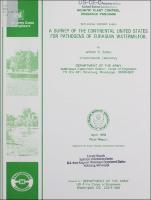Please use this identifier to cite or link to this item:
https://hdl.handle.net/11681/6421Full metadata record
| DC Field | Value | Language |
|---|---|---|
| dc.contributor.author | Zattau, William C. | en_US |
| dc.creator | Aquatic Plant Control Research Program (U.S.) | en_US |
| dc.creator | Environmental Laboratory (U.S.) | en_US |
| dc.date.accessioned | 2016-03-23T19:55:37Z | en_US |
| dc.date.available | 2016-03-23T19:55:37Z | en_US |
| dc.date.issued | 1988-04 | en_US |
| dc.identifier.govdoc | Technical Report A-88-3 | en_US |
| dc.identifier.uri | http://hdl.handle.net/11681/6421 | en_US |
| dc.description | Technical Report | en_US |
| dc.description.abstract | A survey of the continental United States for pathogens of Myriophyllum spicatum (Eurasian watermilfoil) was conducted. More than 50 water bodies, located in 10 states, were sampled for diseased plants. Sample sites represented a geographic and climatic cross section of aquatic systems in the continental United States, including ponds, lakes, reservoirs, rivers, and canals. At the conclusion of the survey, 792 isolates had been collected from tissue samples and maintained in pure culture. Of these, 462 were bacteria and 330 were fungi; many isolates were duplicates but were retained because they possibly represented different strains of the same species. Lytic enzyme assays indicated that 14 bacterial and 22 fungal isolates produced pectinase or cellulose. Enzyme assays were used to screen for the more promising isolates for additional study as potential biocontrol agents for the management of Eurasian watermilfoil. The 36 isolates were then assayed against healthy sprigs of the target species in test tubes. Results indicated that five fungal isolates should be considered for additional study. | en_US |
| dc.description.sponsorship | Aquatic Plant Control Research Program (U.S.) | en_US |
| dc.description.sponsorship | United States. Army. Corps of Engineers | en_US |
| dc.description.tableofcontents | Preface......................1 List of Tables......................4 List of Figures......................4 Part I: Introduction......................5 Background......................5 Conventional Control......................6 Biological Control Agents of Eurasian Watermilfoil......................6 Approach......................8 Rationale......................8 Purpose and Objectives......................9 Part II: Materials and Methods......................10 Site Selection......................10 Site Descriptions......................10 Collection of Samples......................13 Processing of Samples......................13 Lytic Enzyme Screening......................16 Inoculum Viability......................16 Test Tube Assay......................16 Reisolation......................17 Identification of Isolates......................18 Part III: Results......................20 Observed Pathology......................20 Isolate Colelction......................20 Lytic Enzyme Assay......................21 Isolate Identification......................21 Inoculum Viability......................21 Test Tube Assay......................21 Part IV: Discussion......................27 Field Observations......................27 Isolate Pathology......................27 Part V: Conclusions and Recommendations......................29 References......................30 Appendix A: Dates and Locations of Collections of Eurasian Watermilfoil......................A1 Appendix B: Ranked Weekly Mean Damage Index Values for Fungal Isolates......................B1 Appendix C: Ranked Weekly Mean Damage Index Values for Bacterial Isolates......................C1 Appendix D: Analysis of Variance of Lytic Enzyme Positive Fungal Isolates......................D1 | en_US |
| dc.format.extent | 47 pages/7.15 MB | en_US |
| dc.format.medium | en_US | |
| dc.language.iso | en_US | en_US |
| dc.publisher | U.S. Army Engineer Waterways Experiment Station | en_US |
| dc.relation | http://acwc.sdp.sirsi.net/client/en_US/search/asset/1043712 | en_US |
| dc.relation.ispartofseries | Technical Report (Aquatic Plant Control Research Program (U.S.)) ; no.Technical Report A-88-3 | en_US |
| dc.rights | Approved for public release; distribution is unlimited | en_US |
| dc.source | This Digital Resource was created from scans of the Print Resource | en_US |
| dc.subject | Eurasian watermilfoil | en_US |
| dc.subject | Myriophyllum spicatum | en_US |
| dc.subject | Pathogen | en_US |
| dc.subject | Survey | en_US |
| dc.subject | Bacteria | en_US |
| dc.subject | Fungi | en_US |
| dc.subject | Biological control | en_US |
| dc.subject | Biocontrol | en_US |
| dc.subject | Aquatic plants | en_US |
| dc.subject | Aquatic weeds | en_US |
| dc.subject | Aquatic Plant Control Research Program (U.S.) | en_US |
| dc.title | A survey of the continental United States for pathogens of Eurasian watermilfoil | en_US |
| dc.type | Report | en_US |
| Appears in Collections: | Technical Report | |
Files in This Item:
| File | Description | Size | Format | |
|---|---|---|---|---|
| TR-A-88-3.pdf | Technical Report A-88-3 | 7.15 MB | Adobe PDF |  View/Open |